The AMD 3rd Gen Ryzen Deep Dive Review: 3700X and 3900X Raising The Bar
by Andrei Frumusanu & Gavin Bonshor on July 7, 2019 9:00 AM EST** = Old results marked were performed with the original BIOS & boost behaviour as published on 7/7.
Gaming: Ashes Classic (DX12)
Seen as the holy child of DirectX12, Ashes of the Singularity (AoTS, or just Ashes) has been the first title to actively go explore as many of the DirectX12 features as it possibly can. Stardock, the developer behind the Nitrous engine which powers the game, has ensured that the real-time strategy title takes advantage of multiple cores and multiple graphics cards, in as many configurations as possible.
As a real-time strategy title, Ashes is all about responsiveness during both wide open shots but also concentrated battles. With DirectX12 at the helm, the ability to implement more draw calls per second allows the engine to work with substantial unit depth and effects that other RTS titles had to rely on combined draw calls to achieve, making some combined unit structures ultimately very rigid.
Stardock clearly understand the importance of an in-game benchmark, ensuring that such a tool was available and capable from day one, especially with all the additional DX12 features used and being able to characterize how they affected the title for the developer was important. The in-game benchmark performs a four minute fixed seed battle environment with a variety of shots, and outputs a vast amount of data to analyze.
For our benchmark, we run Ashes Classic: an older version of the game before the Escalation update. The reason for this is that this is easier to automate, without a splash screen, but still has a strong visual fidelity to test.
| AnandTech CPU Gaming 2019 Game List | ||||||||
| Game | Genre | Release Date | API | IGP | Low | Med | High | |
| Ashes: Classic | RTS | Mar 2016 |
DX12 | 720p Standard |
1080p Standard |
1440p Standard |
4K Standard |
|
Ashes has dropdown options for MSAA, Light Quality, Object Quality, Shading Samples, Shadow Quality, Textures, and separate options for the terrain. There are several presents, from Very Low to Extreme: we run our benchmarks at the above settings, and take the frame-time output for our average and percentile numbers.
All of our benchmark results can also be found in our benchmark engine, Bench.
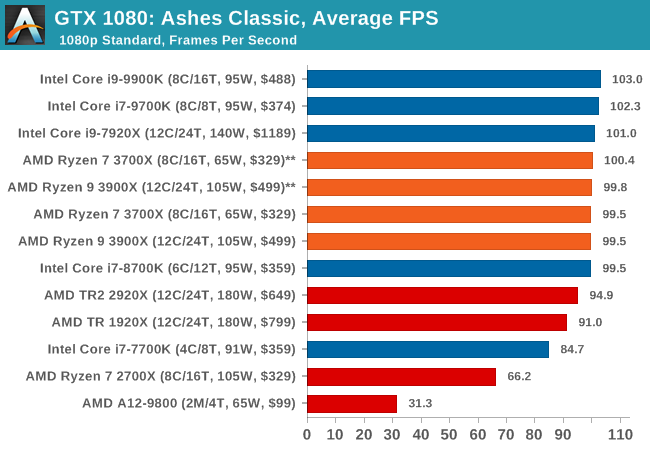
| Ashes Classic | IGP | Low | Medium | High |
| Average FPS | 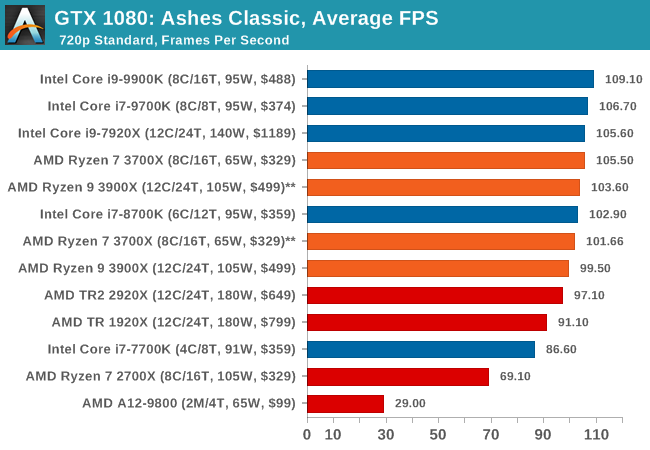 |
 |
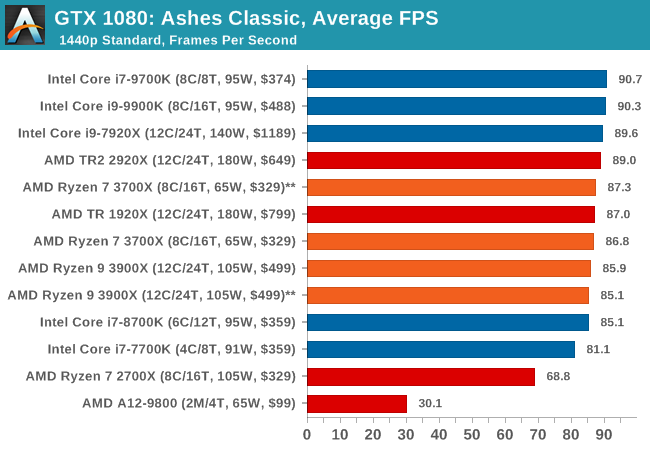 |
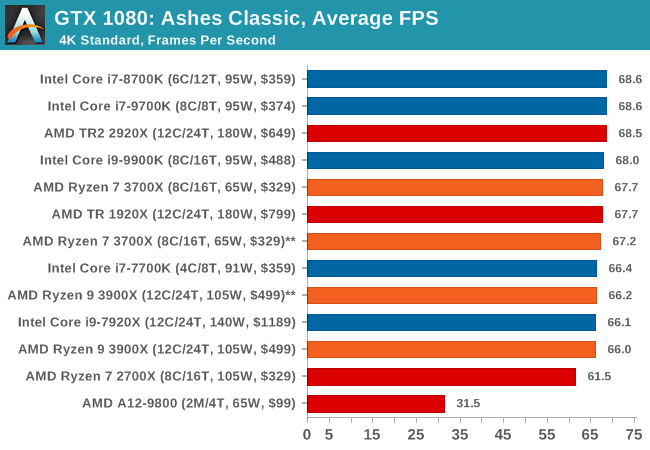 |
| 95th Percentile | 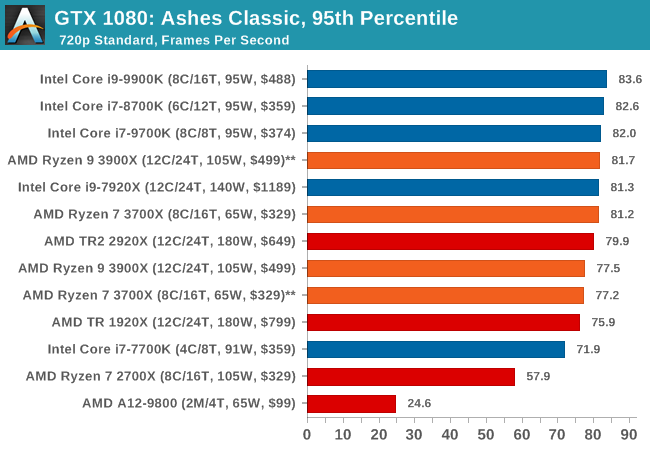 |
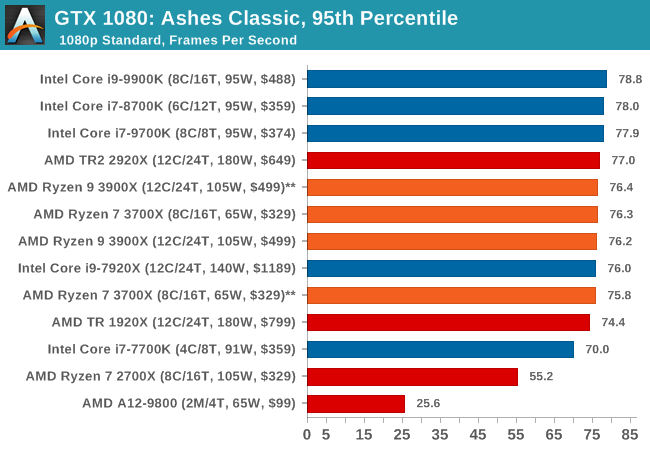 |
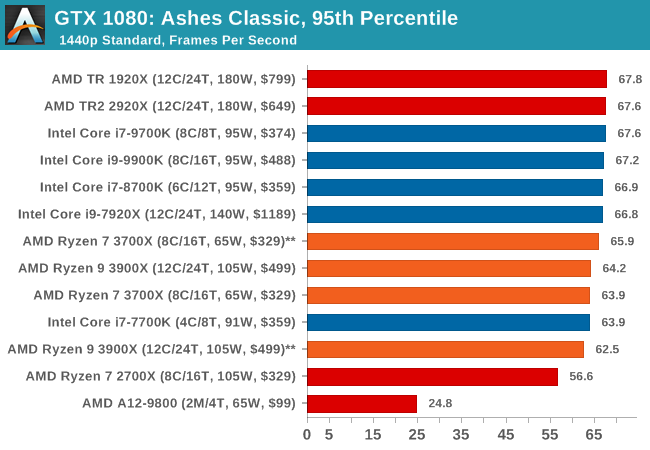 |
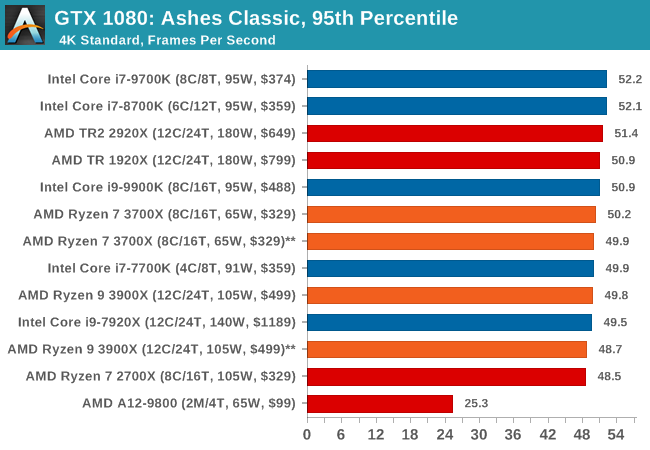 |


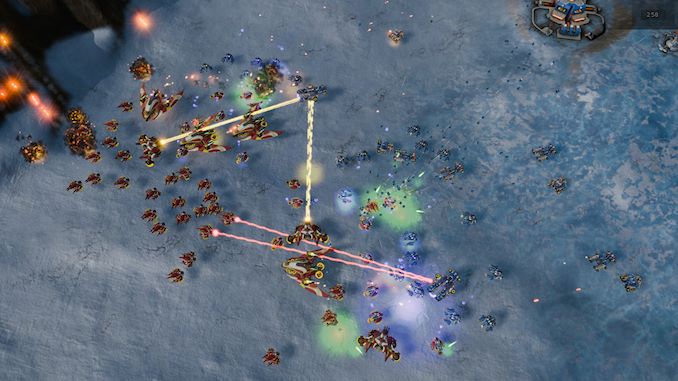








447 Comments
View All Comments
shakazulu667 - Sunday, July 7, 2019 - link
Is there a compilation test coming for chromium or another big source tree, that would show if new IO arch brings wider benefits for such CPU+IO workloads?Andrei Frumusanu - Sunday, July 7, 2019 - link
We'll be re-adding the Chromium compile test in the next few days - there were a few technical hiccups when running it.shakazulu667 - Sunday, July 7, 2019 - link
Thanks, I'm looking forward to it, especially curious if AMD can utilize NVMe better for this kind of workload.Andrei Frumusanu - Sunday, July 7, 2019 - link
Unfortunately we don't test the CPU suite with different SSDs for this.shakazulu667 - Sunday, July 7, 2019 - link
Is there another test in your suite that could show improvements with IO , incl NVMe?RSAUser - Monday, July 8, 2019 - link
But one of the big features is PCIe 4 support, so testing with an nvme drive as well to show difference would be important? People spending $490 on a CPU only are probably going to be buying an Nvme SSD.A5 - Monday, July 8, 2019 - link
There aren't any PCIe 4 SSDs for them to test with.0ldman79 - Monday, July 8, 2019 - link
Yep, PCIe 4.0 NVME is going to be beta at this point at best.Last I read the first 4.0 NVME to be released is essentially running an overclocked 3.0 interface, which the list of NVME that can saturate 3.0 is pretty short as it is.
RSAUser - Tuesday, July 9, 2019 - link
That's because these are the first PCIe 4 slots that exist, can't release a product that can't even be used.Using an overlocked drive in lieu of a 4 one is the proper thing to do.
Kevin G - Tuesday, July 9, 2019 - link
For consumers yes but the first PCIe 4.0 host system was the IBM POWER9 released ~18 months ago. As such there are a handful of NIC and accelerators for servers out there today.The real oddity is that nVidia doesn’t support PCIe 4.0. Volta’s nvLink has a PHY based upon PCIe 4.0. Turing should as well though nVidia doesn’t par those chips with the previously mentioned POWER9.